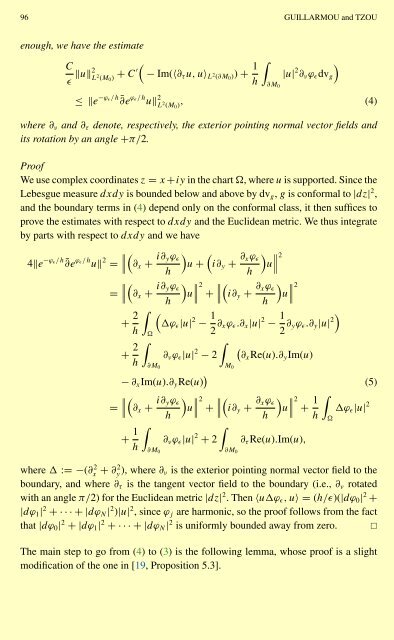NEAR OPTIMAL BOUNDS IN FREIMAN'S THEOREM
NEAR OPTIMAL BOUNDS IN FREIMAN'S THEOREM
NEAR OPTIMAL BOUNDS IN FREIMAN'S THEOREM
Create successful ePaper yourself
Turn your PDF publications into a flip-book with our unique Google optimized e-Paper software.
96 GUILLARMOU and TZOU<br />
enough, we have the estimate<br />
C<br />
ɛ u2 L2 <br />
(M0) + C′ − Im(〈∂τ u, u〉L2 (∂M0)) + 1<br />
h<br />
<br />
∂M0<br />
|u| 2 ∂νϕɛdvg<br />
≤e −ϕɛ/h¯∂e ϕɛ/h 2<br />
uL2 (M0) , (4)<br />
where ∂ν and ∂τ denote, respectively, the exterior pointing normal vector fields and<br />
its rotation by an angle +π/2.<br />
Proof<br />
We use complex coordinates z = x +iy in the chart , where u is supported. Since the<br />
Lebesgue measure dxdy is bounded below and above by dvg, g is conformal to |dz| 2 ,<br />
and the boundary terms in (4) depend only on the conformal class, it then suffices to<br />
prove the estimates with respect to dxdy and the Euclidean metric. We thus integrate<br />
by parts with respect to dxdy and we have<br />
4e −ϕɛ/h¯∂e ϕɛ/h<br />
<br />
2 <br />
u = ∂x + i∂yϕɛ<br />
<br />
u + i∂y +<br />
h<br />
∂xϕɛ<br />
<br />
<br />
u<br />
h<br />
2<br />
<br />
<br />
= ∂x + i∂yϕɛ<br />
<br />
<br />
u<br />
h<br />
2 <br />
<br />
+ i∂y + ∂xϕɛ<br />
<br />
<br />
u<br />
h<br />
2<br />
+ 2<br />
<br />
ϕɛ|u|<br />
h <br />
2 − 1<br />
2 ∂xϕɛ.∂x|u| 2 − 1<br />
<br />
2<br />
∂yϕɛ.∂y|u|<br />
2<br />
+ 2<br />
<br />
∂νϕɛ|u|<br />
h ∂M0<br />
2 <br />
<br />
− 2 ∂xRe(u).∂yIm(u)<br />
M0<br />
− ∂xIm(u).∂yRe(u) <br />
(5)<br />
<br />
<br />
= ∂x + i∂yϕɛ<br />
<br />
<br />
u<br />
h<br />
2 <br />
<br />
+ i∂y + ∂xϕɛ<br />
<br />
<br />
u<br />
h<br />
2<br />
+ 1<br />
<br />
ϕɛ|u|<br />
h <br />
2<br />
+ 1<br />
<br />
∂νϕɛ|u|<br />
h ∂M0<br />
2 <br />
+ 2 ∂τ Re(u).Im(u),<br />
∂M0<br />
where := −(∂ 2 x + ∂2 y ), where ∂ν is the exterior pointing normal vector field to the<br />
boundary, and where ∂τ is the tangent vector field to the boundary (i.e., ∂ν rotated<br />
with an angle π/2) for the Euclidean metric |dz| 2 .Then〈uϕɛ,u〉=(h/ɛ)(|dϕ0| 2 +<br />
|dϕ1| 2 +···+|dϕN| 2 )|u| 2 ,sinceϕj are harmonic, so the proof follows from the fact<br />
that |dϕ0| 2 +|dϕ1| 2 +···+|dϕN| 2 is uniformly bounded away from zero. <br />
Themainsteptogofrom(4) to(3) is the following lemma, whose proof is a slight<br />
modification of the one in [19, Proposition 5.3].

















